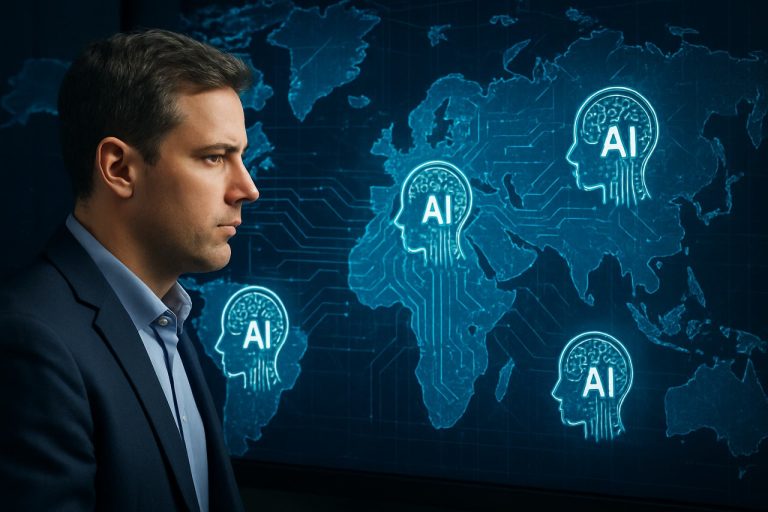
- The landscape of technology is evolving, aiming for seamless integration between human ingenuity and digital progress.
- Cryptographic finance is undergoing a transformation with firms like Circle, BitGo, and Coinbase pivoting towards traditional banking roles under regulatory influences like the STABLE Act.
- The collective aim is to establish globally integrated financial systems and a universal crypto ecosystem that enhances Web3 prospects.
- In contrast, centralized cloud systems are creating environmental concerns, as highlighted by Nvidia’s significant investment in fossil-fueled power to support AI advances.
- Decentralized cloud networks present a more sustainable and cost-effective alternative, potentially reshaping future tech economies.
- The key to forging a successful future lies in balancing innovation with ethical sustainability and resource management.
Beneath the shimmering allure of futuristic promises, a quiet revolution churns with steadfast ambition. As the digital cosmos expands and reshapes the very fabric of our daily lives, whispers of a new dawn are growing louder, fueled by a rush of innovation and an unyielding quest for progress. From the glistening towers of Silicon Valley to the strategic halls of financial power, the contours of a transformative landscape take shape, with a magnificent vision: a world where technology and human ingenuity dance seamlessly.
However, the path is fraught with labyrinthine challenges and flickers of controversy. Take the burgeoning movement in the cryptographic landscape, for instance. Under the influence of regulatory shifts like the STABLE Act, key players such as Circle, BitGo, and Coinbase are considering bank charters—a startling pivot that would weave them into the very fabric of traditional banking. Imagine these titans gathering deposits, spinning them into lucrative loans that echo conventional financial practices. Such a metamorphosis aligns legality with profitability, promising crypto’s elevation beyond speculative whispers.
Yet, this is not a simple tale of adaptation. At its core, it’s a revealing puzzle piece of a grander picture—one of global financial integration and digital inclusivity. As the whispers of a prospective payment network from Circle tease the potential to outrun giants like Visa and Mastercard, the dream of Web3 draws nearer. But the vision demands more: a universal crypto ecosystem with fluid interfaces and seamless wallet-to-bank transactions, framed within a robust digital identity structure. The dream beckons, but realization requires collective endeavor and visionary leaps into interoperability—an adventure Circle has boldly embarked upon, pushing the frontier.
Meanwhile, a different narrative unfolds in the energy-laden realm of centralized cloud systems. A stark juxtaposition presents itself as Nvidia, instrumental in AI’s dawn, rallies Japan to embrace a $44 billion investment in fossil-fueled power. The ambition: fuel the monster appetite of GPUs to advance AI’s prodigies. Critics point fingers at crypto mining’s carbon footprint, yet the reality of voracious data centers—a demand poised to double by 2030—is a sobering counterpoint. These epicenters of digital might, epitomized by Nvidia’s hardware, hoist a hefty toll. The irony ensues as emerging Chinese AI forces demonstrate the redundancy of such monumental GPU reliance.
Herein lies an enticing proposition: decentralized cloud networks promising a tectonic shift. Research touts these networks as feasibly 80% to 90% cheaper than elite providers like AWS. Alongside financial and ecological inducements, a narrative frames this pivot not merely as an option but an industry imperative—a crescendo of decentralizing energy that’s recasting tomorrow’s tech economy.
In this evolving saga, the takeaways orbit an essential truth: the future we forge demands not only innovation but also a rigorous alignment with ethical sustainability. As tech’s adventurers—both present and future—chart these promising waters, the message resonates clearly: progress is best galvanized through shared purpose and enlightened stewardship of resources. Thus, we might truly craft a resilient digital realm, attuned to both human potential and planetary constraints.
The Technology Revolution: Beyond Innovation to a Sustainable Future
The Digital Transformation: A Dual Challenge
As the digital revolution advances, the integration of cutting-edge technology with traditional systems poses both exciting opportunities and significant challenges. This inevitable shift is reshaping financial services, energy consumption, and computing infrastructure.
The Emerging Role of Crypto in Traditional Banking
The STABLE Act is shaping the future of crypto by encouraging major players, including Circle, BitGo, and Coinbase, to consider securing bank charters. This transformation could allow these companies to collect deposits and manage loans like traditional banks. With the prospective payment network from Circle challenging Visa and Mastercard, the potential for a universal crypto ecosystem becomes tangible.
Real-World Use Cases
1. Seamless Transactions: The move could lead to simpler and more efficient wallet-to-bank transactions, promoting greater financial inclusivity.
2. Regulatory Compliance: Aligning with regulatory standards ensures not only legal safety but also long-term viability.
For more insights on the world of crypto and its latest developments, explore Coinbase.
The Energy Quandary and Decentralized Clouds
The centralization of cloud systems, illustrated by Nvidia’s $44 billion fossil-fuel investment in Japan, highlights the resource-intensive nature of data centers. Yet, decentralized cloud solutions propose an energy-efficient alternative that could drastically reduce costs.
Market Forecasts & Industry Trends
1. Reduced Costs: Decentralized networks might offer services up to 90% cheaper than traditional cloud providers such as AWS.
2. Sustainability: These solutions promise a lower carbon footprint, critical as data center demand doubles by 2030.
For more on sustainable energy solutions, visit Nvidia.
Pressing Questions and Concerns
– What are the limitations of the current system? The reliance on traditional energy sources poses sustainability issues, driving the need for decentralization.
– How might these changes impact everyday users? Users can expect more efficient financial services and potential cost reductions for cloud-based applications.
Insights & Predictions
– Decentralization Will Lead: The future will likely see a shift towards decentralized systems, reducing reliance on high-cost, energy-intensive data centers.
– Technology and Ethics: Aligning tech advancements with ethical and sustainable practices is crucial for long-term success.
Actionable Recommendations
– Adopt Sustainable Practices: Companies should prioritize eco-friendly technologies to stay ahead.
– Regulatory Alignment: Businesses in the crypto space must align with legal standards to ensure future growth.
Conclusion
The path to digital transformation necessitates not just technological innovation but a collective push towards sustainability and ethical stewardship. By navigating these challenges wisely and purposefully, we can build a digital future that honors both human ingenuity and planetary limits.



